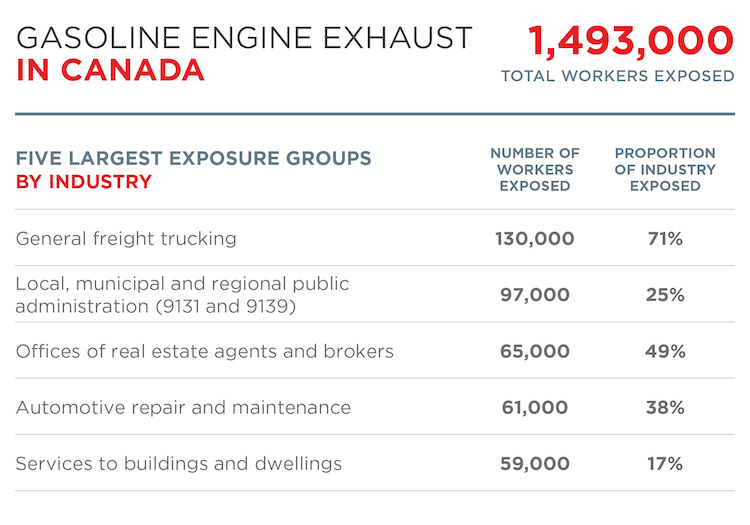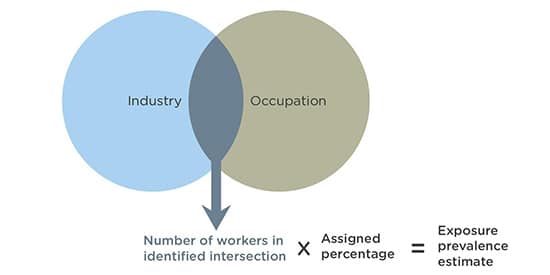Gasoline Engine Exhaust Occupational Exposures
Gasoline Engine Exhaust Occupational Exposures
Overview
Inhalation is the primary route of occupational exposure to gasoline engine exhaust.[1] CAREX Canada estimates that approximately 1.5 million Canadians are exposed to gasoline engine exhaust in their workplace.
READ MORE...
The largest industrial groups exposed include freight trucking, local, municipal and regional public administration, and offices of real estate agents and brokers. Occupations at risk of gasoline engine exhaust exposure include transport truck drivers, delivery and courier service drivers, bus drivers, subway operators and other transit operators, and real estate agents and salespersons.
Prevalence Estimate
Results show that approximately 1.5 million Canadians are occupationally exposed to gasoline engine exhaust, accounting for 8% of the working population in Canada. The majority of exposed workers are male (82%). The largest industrial groups exposed include freight trucking, local, municipal and regional public administration, and offices of real estate agents and brokers. Occupations at risk of gasoline engine exhaust exposure include transport truck drivers (315,000 workers exposed), delivery and courier service drivers (94,000 workers exposed), bus drivers, subway operators and other transit operators (83,000 workers exposed), and real estate agents and salespersons (65,000 workers exposed).
Workers exposed to gasoline engine exhaust by industry in 2016

Workers exposed to gasoline engine exhaust by region in 2016
Click the second tab to view total number of workers exposed.
Level of Exposure
In total, approximately 1.5 million Canadians are exposed to gasoline engine exhaust in their workplaces. The majority of workers exposed to gasoline engine exhaust are in the low exposure category (70%). A significant number of gasoline exhaust-exposed workers are at risk for moderate to high exposure.
Workers exposed to gasoline engine exhaust by exposure level in 2016
Level of exposure by industry
Identifying industries with either 1) workers exposed to high levels of gasoline engine exhaust or 2) a larger number of workers exposed to gasoline engine exhaust is important in guiding cancer prevention efforts to prioritize exposed groups and target resources most effectively.
The table below shows the number of workers exposed by industry group and level of exposure to gasoline engine exhaust. These results highlight industries with the most number of workers, as well as industries with the highest levels of exposure. For example, the largest numbers of exposed workers are employed in the transport industries (e.g. industry codes 484, 485), where exposure mainly occurs at low levels. Other industries (e.g. repair and maintenance) have lower numbers of exposed workers overall, but exposure levels are higher due to more direct work with sources of gasoline engine exhaust. Depending on the goals of a prevention campaign, exposure reduction in the large industrial group might be a useful strategy, or reducing exposure to those at highest risk of exposure could be seen as a priority.
Workers exposed to gasoline engine exhaust by exposure level and industry in 2016
Methods and Data
Our Occupational Approach page outlines the general approach used to calculate prevalence and exposure level estimates for workplace exposures.
Data Sources
Data used in developing the occupational estimates for gasoline engine exhaust were collected from several sources:
- The Canadian General Population Job-Exposure Matrix (CANJEM), which was built from expert evaluations of occupational exposures in four case-control studies conducted from the mid-1980s up to 2010 in the greater Montreal area. Approximately 10,000 individuals were evaluated by experts who assigned exposures based on descriptions of work tasks, processes, work environment, and exposure control measures.
- Canadian and US scientific peer reviewed publications that addressed gasoline engine exhaust exposure in Canada and the United States.
- Grey literature including technical reports from governments and international bodies.
Prevalence Estimate Method
CAREX defines exposure to gasoline engine exhaust as inhalation exposure at work above the levels expected in the general environment (i.e. from living close to a highway). To determine the number of workers potentially exposed to gasoline engine exhaust at work, CAREX occupational exposure experts used methods previously established in other peer-reviewed CAREX projects in Europe. A series of steps were taken to assign exposure proportions to occupations and industries at risk of exposure to gasoline engine exhaust.

- Occupations and industries at risk of possible exposure to gasoline engine exhaust were identified using any combination of data sources described above.
- The total number of workers in each identified occupation and industry intersection was obtained from Statistics Canada 2016 census data.
- A percentage of workers exposed was assigned to that occupation and industry intersection. Percentages were determined by consultation with existing evidence in the data sources, previously established methods from the Europe CAREX estimates and the expert judgement of CAREX occupational hygienists.
- The number of workers in the identified group is multiplied by the assigned percentage to calculate the prevalence estimate of workers exposed to gasoline engine exhaust.
Exposure Level Method
CAREX regularly uses available workplace exposure measurements in the CWED to create exposure level categories by industry and occupation. For gasoline engine exhaust, these were not available due to a lack of a regulatory exposure limits. Therefore, categories of exposure were created as follows:
Category 1: Low Exposure
A group of workers (people in the same job category and industry) is put in this exposure category if:
- Workers occasionally spend time working with or near gas engine equipment, or
- Workers spend a considerable portion of the workday in high-traffic areas.
Category 2: Moderate Exposure
A group of workers is put in this exposure category if:
- Workers directly work with gas-powered equipment, or
- They work in close proximity to gas-powered equipment.
Category 3: High Exposure
A group of workers is put in this exposure category if they directly use gas-powered equipment/vehicles/devices in spaces with reduced ventilation (e.g. in indoor environments, with partial covering of the workspace).
Sources
Subscribe to our newsletters
The CAREX Canada team offers two regular newsletters: the biannual e-Bulletin summarizing information on upcoming webinars, new publications, and updates to estimates and tools; and the monthly Carcinogens in the News, a digest of media articles, government reports, and academic literature related to the carcinogens we’ve classified as important for surveillance in Canada. Sign up for one or both of these newsletters below.
CAREX Canada
School of Population and Public Health
University of British Columbia
Vancouver Campus
370A - 2206 East Mall
Vancouver, BC V6T 1Z3
CANADA
As a national organization, our work extends across borders into many Indigenous lands throughout Canada. We gratefully acknowledge that our host institution, the University of British Columbia Point Grey campus, is located on the traditional, ancestral, and unceded territories of the xʷməθkʷəy̓əm (Musqueam) people.



